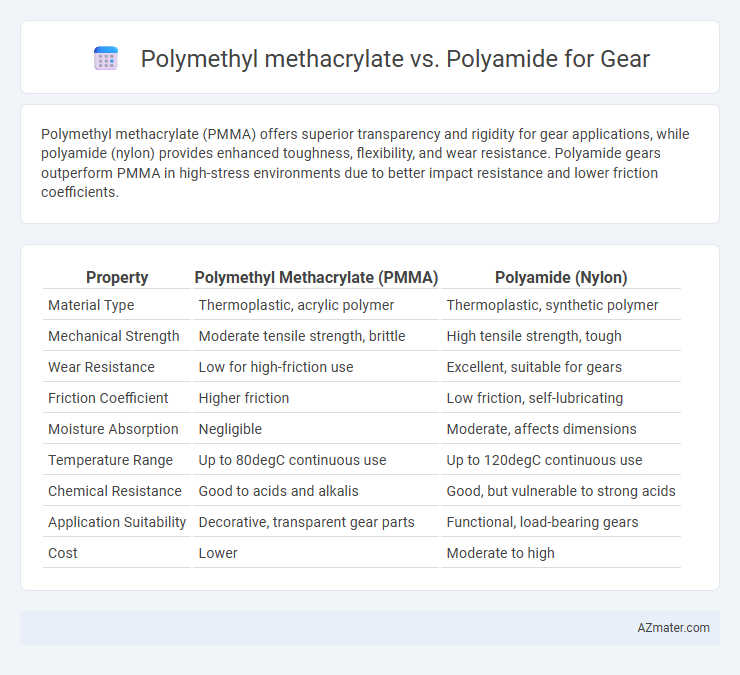Polymethyl methacrylate (PMMA) offers superior transparency and rigidity for gear applications, while polyamide (nylon) provides enhanced toughness, flexibility, and wear resistance. Polyamide gears outperform PMMA in high-stress environments due to better impact resistance and lower friction coefficients.
Table of Comparison
| Property | Polymethyl Methacrylate (PMMA) | Polyamide (Nylon) |
|---|---|---|
| Material Type | Thermoplastic, acrylic polymer | Thermoplastic, synthetic polymer |
| Mechanical Strength | Moderate tensile strength, brittle | High tensile strength, tough |
| Wear Resistance | Low for high-friction use | Excellent, suitable for gears |
| Friction Coefficient | Higher friction | Low friction, self-lubricating |
| Moisture Absorption | Negligible | Moderate, affects dimensions |
| Temperature Range | Up to 80degC continuous use | Up to 120degC continuous use |
| Chemical Resistance | Good to acids and alkalis | Good, but vulnerable to strong acids |
| Application Suitability | Decorative, transparent gear parts | Functional, load-bearing gears |
| Cost | Lower | Moderate to high |
Introduction to Gear Materials
Polymethyl methacrylate (PMMA) and polyamide (nylon) are widely used materials in gear manufacturing due to their distinct mechanical and chemical properties. PMMA offers excellent transparency, high stiffness, and good wear resistance, making it suitable for precision gears in low-load applications. Polyamide provides superior toughness, higher impact resistance, and excellent fatigue strength, ideal for gears operating under heavy loads and dynamic stresses.
Overview of Polymethyl Methacrylate (PMMA)
Polymethyl methacrylate (PMMA) is a transparent thermoplastic known for its exceptional clarity, high tensile strength, and excellent weather resistance, making it suitable for precision gears in applications requiring low friction and minimal wear. PMMA exhibits superior rigidity and dimensional stability compared to polyamide, yet it is less impact-resistant and offers lower flexibility. Its resistance to UV light and chemicals makes PMMA ideal for gear components exposed to harsh environmental conditions where maintaining optical clarity and structural integrity is critical.
Overview of Polyamide (Nylon)
Polyamide (Nylon) exhibits excellent mechanical strength, fatigue resistance, and chemical stability, making it ideal for durable gear applications. Its high wear resistance and self-lubricating properties enable smooth operation under load and reduce maintenance needs. Compared to Polymethyl methacrylate (PMMA), Nylon offers superior impact resistance and flexibility, crucial for gears subjected to dynamic stresses.
Mechanical Properties Comparison
Polymethyl methacrylate (PMMA) exhibits high rigidity and excellent tensile strength, making it suitable for gears requiring dimensional stability and wear resistance under moderate loads. Polyamide (nylon) offers superior impact resistance, higher toughness, and better fatigue resistance, enabling gears to perform effectively under dynamic and high-load conditions. The choice between PMMA and polyamide gears depends on the required balance between stiffness, durability, and load-bearing capacity in specific mechanical applications.
Wear and Friction Behavior
Polymethyl methacrylate (PMMA) exhibits lower friction coefficients but higher wear rates compared to polyamide when used in gear applications, primarily due to its brittle nature and lower impact resistance. Polyamide gears demonstrate superior wear resistance and self-lubricating properties, resulting in enhanced durability and reduced friction under varying load conditions. Optimizing gear performance requires balancing PMMA's smooth surface finish against polyamide's toughness and wear stability for specific operational environments.
Chemical and Thermal Resistance
Polymethyl methacrylate (PMMA) offers excellent chemical resistance against alkalis, dilute acids, and many solvents, maintaining structural integrity under moderate thermal conditions up to 80-100degC. Polyamide (Nylon) features superior thermal resistance, tolerating continuous use temperatures around 120-150degC, and exhibits strong resistance to oils, fuels, and greases, making it suitable for high-stress gear applications. While PMMA provides good dimensional stability and clarity, polyamide's enhanced toughness and heat endurance deliver better performance in chemically aggressive and thermally demanding environments.
Machinability and Manufacturing
Polymethyl methacrylate (PMMA) offers excellent machinability for gears due to its ease of cutting and polishing, resulting in precise, smooth surfaces suitable for low-load applications. Polyamide (PA), or nylon, demands more careful machining but provides superior toughness and wear resistance, making it ideal for more durable gear manufacturing processes. Manufacturing with PMMA is typically faster and cost-effective owing to its rigidity and dimensional stability, whereas polyamide requires controlled conditions to manage moisture absorption and maintain performance during production.
Cost Analysis
Polymethyl methacrylate (PMMA) typically offers lower initial material costs compared to polyamide (nylon) for gear manufacturing, making it suitable for budget-sensitive applications. However, polyamide provides superior durability and wear resistance, potentially reducing long-term maintenance and replacement expenses. When evaluating total cost of ownership, polyamide gears may present better value despite higher upfront costs due to increased lifespan and performance under mechanical stress.
Suitability for Gear Applications
Polymethyl methacrylate (PMMA) offers excellent dimensional stability and high resistance to wear, making it suitable for gears requiring low friction and smooth operation in lightweight machinery. Polyamide (nylon) demonstrates superior toughness, impact resistance, and self-lubricating properties, which are ideal for gears subjected to heavy loads, high stress, and frictional heat in industrial applications. The choice between PMMA and polyamide depends largely on operational demands such as load capacity, environmental exposure, and the need for impact resistance versus dimensional precision.
Conclusion: PMMA vs Polyamide for Gears
Polymethyl methacrylate (PMMA) offers excellent rigidity and wear resistance, making it suitable for gears requiring high precision and minimal deformation under load. Polyamide (PA), commonly known as nylon, provides superior toughness, impact resistance, and self-lubricating properties, which enhance gear durability in dynamic or high-friction environments. For gears, PMMA is ideal when stiffness and dimensional stability are paramount, while polyamide excels in applications demanding flexibility, impact absorption, and reduced friction.

Infographic: Polymethyl methacrylate vs Polyamide for Gear
 azmater.com
azmater.com